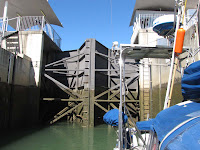We had talked about leaving early but then decided to stay, so at 11 o'clock we hoisted sails, sailed over the start line, and headed out to Banda. The winds were light from the stern, and we enjoyed a day and evening of lovely sailing. On Sunday morning the winds began to build, and we picked up our pace. By Monday, the winds were between 25 and 30 knots, and the seas were once again short and steep. We triple reefed the main and later reefed the jib. The good news was that we were making very good time. Tuesday morning, the wind backed off but then a series of squalls came over, and one produced 38 knot gusts. By mid-morning everything was back to normal, and we enjoyed trade-wind sailing for the rest of the time.
We arrived at Banda at 1 o'clock in the morning. The winds were light, and we enjoyed light from the full moon so we entered the bay with no problems. The problem occurred when we looked for a place to anchor because the shore drops off steeply and quickly. After motoring around for 45 minutes and dropping and retrieving the anchor in 125 feet, we ended up in 160 feet of water with 200 feet of chain plus 100 feet of rope rode out. We decided that we would deal with finding a better location in the morning.
We were able to sleep until 7 a.m. when the bosun's whistle from the medical ship anchored next to us sounded. The government has converted a war ship into a medical ship that visits the islands and takes care of the needs of the locals. We got up and began to make the boat presentable for the officials. We notified them on the VHF radio that we had arrived, and around 9 o'clock the Customs, Immigration, and Quarantine officials came aboard to check us in. Everything went very smoothly, and they were very friendly and polite. When they finished, the Customs official asked Steve to come with him to shore and to be sure to bring our boat stamp. Steve took him in our dinghy while I stayed on board. A little later Steve returned and told me that there was no problem, but he had to sign six documents, each of which had about eight copies that also had to be signed and, of course, stamped with our boat stamp. It seemed very important to them to have the boat stamp on all documents.
We quickly got ready to go ashore because there were many events scheduled for the day. We walked into town and arrived at the pavilion where all the festivities were happening. We were told that the two main buildings and the bandstand had just been built for this event. We were shown to chairs under an awning and each given a gift and food. The gift was a memento of the event, and the food was in a small box that included several small but delicious items and a container of water. We then listened to several speeches by national and local officials. When they were done, we were treated to dancers dressed in beautiful native costumes who performed local dances for us.
We returned to the boat just after lunch in order to get a bit more sleep. Don and Ann on sv Harmonie came by to ask us to join them and sv Priscilla for dinner so we got ready for the evening and joined them at the dock at 5:30. We walked through the streets and found a local's home that was also a restaurant. We all ordered our meals from a menu that we could not read, and four of us received our meals but two did not. It all worked out in the end, and Steve and I paid our $45,000 rupia, which was about $5 U.S.
We left to walk around for awhile, and then we headed to Fort Belgica for another dance performance. The fort was built in 1532 by the Dutch. We arrived early and were treated to a guided tour by torchlight up to one of the parapets. The path included dark steps and a ladder to reach the parapet. It was very interesting and fun. We then carefully made our way back to the performance area where we were offered front row seats. "Rubber time" happens here, meaning that things never begin when scheduled; however, things finally got started with the usual speeches by officials. Some dances that evening were performed by men and some by women, and they were all wonderful. The costumes were rich and colorful, and we thoroughly enjoyed it all.
We returned to the boat at midnight and were surprised to be treated to a fireworks display from the fort. With that wonderful end to the day, we crashed!
----------
radio email processed by SailMail
for information see: http://www.sailmail.com







.jpg)


.jpg)
.jpg)
.jpg)
.bmp)